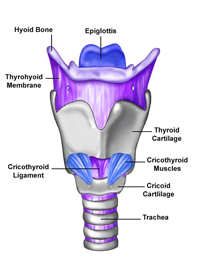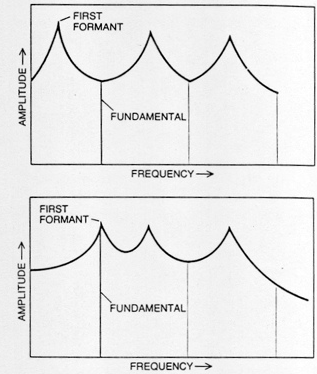Most of the sound generated by the human voice organ can be understood by the fellow humans. We produce sound to express emotion, mental imagery, and language. Human voice is the most natural form of communication involved with environmental and situational reality. Actually a spoken word has more meaning than its explanation in the dictionary.
Human voice is produced from the sound generating structures including lungs, larynx, glottis and voice tract. The three important structures are lungs, vocal cords in the larynx or Sound box and the vocal tract. The power source for generating the voice includes lungs, rib cage, diaphragm and abdominal muscles. These structures generate a controlled air stream that passes through the vocal cords. When the air rushes through the glottis (opening of the wind pipe or trachea), the glottis opens and closes and changes the resistance of air continuously. The power source structures are capable of complex adjustments to keep the quality and loudness of the sound.

Larynx
The vocal cords in the larynx are responsible for the generation of sound. These elatic folds vibrate according to the opening and closing of the glottis. The air stream then passes though the vocal tract act as a resonator for the sound. The vocal tract includes the pharynx, tongue, palatte, oral cavity and the nose. The resonance of these structures determines the quality of the voice produced.

Vocal cords in the larynx
Adult men and women have different vocal folds sizes; reflecting the male-female differences in larynx size. Adult male voices are usually lower-pitched and have larger folds. The male vocal folds, are between 17 mm and 25 mm in length. The female vocal folds are between 12.5 mm and 17.5 mm in length.
The Bernoulli Effect and sound production
The Bernoulli Effect is the reduction of lateral air pressure due to its forward motion. As the air from the lungs passes through the vocal cords, Bernoulli Effect develops in the air. This combines with the elastic property of the vocal cords and causes the vocal cords to shut. When the air pressure below the glottis diminishes, the glottis opens. The excess pressure of air coming from the lungs cause an excess pressure below the glottis and move the vocal cords apart. Due to the Bernoulli Effect, the glottis closes immediately. Due to the difference in the air pressure, the glottis opens again. Thus due to the repetitive and controlled opening and closing of the glottis, a train of air pressure passes into the vocal tract.
Frequency of Human voice
The vibratory frequency of the vocal cords fixes the fundamental frequency of the human voice. The pressure of air from the lungs and the flexibility of the vocal cords determine the fundamental human voice frequency. Thinner vocal cords produce high frequency voice. The frequency of sound also depends on the air pressure in the lungs. The complex tone of the voice is set by a number of higher harmonics. The amplitude of these harmonics decreases with the frequency. Typically this decrease is around 12 dB per octave.
Resonance and Formant
The vocal tract act as the resonator of the voice. The sound from the vocal tract will have peculiar resonant frequencies rich in relative amplitude and relative loudness. The human vocal tract resonates in different frequency. Usually it shows four or more resonances. The Formant is the term applied to describe the resonant frequencies of the voice tract. Formant is defined by Fant as ‘the spectral peaks of the sound spectrum of the voice. The formants are frequency information characteristics of the voice. The formants change their centre frequency and band width during speech.
The fundamental frequency of the resonance depends on the length and shape of the vocal tract. In men the average length of the vocal tract is around 17 centimeters. The frequency of resonance can be determined using the formula
nV / 4L.
n is the positive odd integer, V is the speed of sound in the air and L, the length of the vocal tract. The first four resonant frequencies of male voice range between 500 and 3500 Hz.The formant amplitude is maximum in the glottis and minimum when lips open.
Male and Female Voices
Male and female voices differ in the fundamental frequency. The fundamental frequency of male voice lies in the range of 85 to 180 Hz while that of the female in the range of 150 to 300 Hz. In terms of the Formants, about five formants are required for male voice while four formats for female voice. The formant frequencies of female are higher than that of the male. The difference is very high in the third and fourth formants and least for the first formant. This is mainly due to the length of the voice tract. Voice tract of the female is shorter than that of the male. The formant frequencies are inversely proportional to the length of the voice tract.

Formants
Voice Pitch
The human voice has many components and is created through a myriad of muscle movements. Pitch is an integral part of the human voice. The pitch of the voice is defined as the “rate of vibration of the vocal folds”. The sound of the voice changes as the rate of vibrations varies. As the number of vibrations per second increases, so does the pitch, meaning the voice would sound higher. Faster rates form higher voices, or higher pitches, while slower rates elicit deeper voices, or lower pitches. The vibrations, and the speed at which they vibrate, are dependent on the length and thickness of the vocal cords, as well as the tightening and relaxation of the muscles surrounding them. This explains why women generally have higher voices than men do; women tend to have higher voices because they have shorter vocal cords. The length and thickness of the vocal cords, however, are not the only factors that affect one’s pitch.
Filed Under: Electronic Projects


Questions related to this article?
👉Ask and discuss on Electro-Tech-Online.com and EDAboard.com forums.
Tell Us What You Think!!
You must be logged in to post a comment.